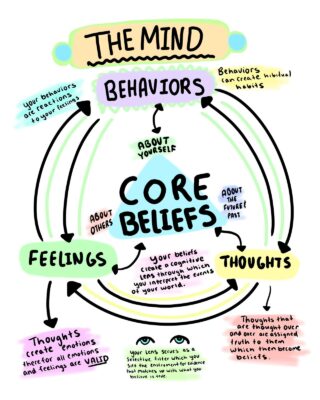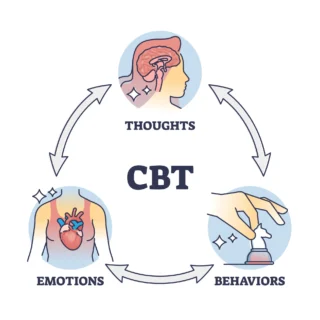Introduction
Imagine living with a constant loop of negative thoughts — “I’m not good enough,” “Nobody will like me,” “What if I fail?” — and each thought drags down your mood, fuelling anxiety or sadness. That’s a place many people quietly endure. But what if there’s a proven method to help you break that cycle, step by step? That method is Cognitive Behavioral Therapy (CBT).
This article is a beginner’s guide to CBT: what it is, how it works, where it helps, and how you can begin applying its principles yourself. Whether you’re exploring therapy for the first time or simply want to understand the science behind mental health tools, this guide walks you through everything clearly and practically.
By the end, you’ll see how CBT empowers you with techniques to shift thought patterns and behaviors — tools you can use long after therapy ends.
What Is CBT? — Foundations and Theory
Origins and History of CBT
CBT’s roots trace back to the 1960s with psychiatrist Aaron T. Beck, who observed that many of his patients suffered not only from emotional symptoms but from consistent patterns of distorted thinking. Beck began to help patients examine and challenge those thought patterns. Over time, behavioral psychology (which emphasized modifying behaviors) was integrated with this cognitive approach, giving us what we call cognitive behavioral therapy.
Unlike therapies that dwell on deep past issues, CBT tends to focus on present thoughts and behaviors. Its evolution has made it one of the most rigorously tested forms of psychotherapy (American Psychological Association).

Core Principles of CBT
At its core, CBT rests on the understanding that thoughts, emotions, and behaviors are tightly interconnected. This is often visualized as a triangle: a change in one corner affects the others.
Key ideas include:
- Automatic thoughts: Spontaneous, sometimes unconscious, interpretations of events (e.g., “She didn’t smile at me — she hates me”).
- Cognitive distortions: Patterns like “all-or-nothing thinking,” “catastrophizing,” or “mind reading” that skew perception negatively (NHS).
- Intermediate beliefs / assumptions: Rules or attitudes you hold (e.g. “If I’m not perfect, I fail”).
- Core beliefs: Deep-seated beliefs about yourself, others, or the world.
- Behavioral activation: Encouraging behaviors that counteract avoidance or withdrawal.
- Behavioral experiments: Testing new ways of behaving to challenge assumptions.
By recognizing and shifting these elements, CBT helps remodel how you interpret your experiences.

How CBT Differs from Other Therapies
CBT is:
- Goal-oriented and structured: Sessions usually follow an agenda and include homework.
- Focused on the present: It deals with current problems rather than extensively exploring the distant past.
- Active and collaborative: You and the therapist work together, with exercises and real-world tasks.
- Time-limited: Many CBT treatments run for 8–20 sessions.
Compared to long-term psychodynamic therapy or more open-ended talk therapy, CBT offers a more direct and practical route to change.
A Beginner’s Guide to Understanding How CBT Works
This section offers the “nuts and bolts” of CBT — what happens, step by step, and how different variants function.
The CBT Process — Step by Step
- Assessment and goal setting – Understanding your challenges and defining clear goals.
- Psychoeducation – Learning how thoughts affect emotions and behaviors.
- Identifying unhelpful thoughts and beliefs – Recognizing negative thought patterns.
- Challenging and reframing thoughts – Testing whether a negative thought is realistic and developing balanced alternatives.
- Behavioral experiments / exposure – Trying new behaviors or facing avoided situations.
- Homework assignments – Practicing tools between sessions.
- Progress evaluation – Reviewing successes and challenges to refine strategies.
Over time, you internalize these skills and become your own best “therapist.”
Types or Variants of CBT
CBT has been adapted into various forms:
- Individual CBT: One-on-one sessions with a trained therapist.
- Group CBT: Small groups meeting under guided structure.
- Brief CBT: Shorter protocols (6–8 sessions), focused on a specific issue.
- CBT for Insomnia (CBT‑I): Tailored to address sleep‑related thoughts and habits (The Guardian).
- CBT for Eating Disorders: Modified protocols for body image or bingeing (NCBI).
- Online / self‑help CBT: Apps, programs, or guided modules you can do with minimal therapist input.
Who Can Use CBT?
CBT has strong empirical support for conditions such as:
- Depression and anxiety (NAMI).
- Obsessive‑Compulsive Disorder (OCD) and Post-Traumatic Stress Disorder (PTSD).
- Phobias and Panic Disorder.
- Insomnia, chronic pain, and stress management (NIH).
However, CBT may not fully suffice when:
- Someone has significant cognitive impairments.
- The case is highly complex with multiple severe comorbidities.
- The person is unwilling or unable to engage actively.
In such cases, CBT is often paired with medication or longer-term therapies.
Benefits, Evidence, and Limitations
Benefits of CBT
- Evidence-based: Supported by robust scientific studies (APA).
- Short-term: Often completed within months.
- Skill-building: Equips you with practical, lifelong coping tools.
- Accessible: Available in clinics, online, or as self-help.
- Low risk: Fewer side effects compared to medication.
Key Research Findings
- Meta-analyses confirm CBT’s efficacy for depression, anxiety, and PTSD.
- Digital CBT (guided apps or online platforms) is proving effective for mild to moderate conditions (Verywell Mind).
- Benefits often persist beyond therapy, showing long-term effectiveness.
Limitations and Criticisms
- Homework adherence: Can be challenging for some clients.
- Discomfort: Facing distressing thoughts may feel difficult.
- Dropout risk: Higher if expectations are unrealistic.
- Not a panacea: Some conditions require medication or deeper therapies.
- Critiques: Some argue CBT oversimplifies complex issues (Psychology Today).
How to Get Started: Practical Implementation (for Beginners)
Choosing a Therapist or Program
When selecting a CBT therapist, look for:
- Verified licensing and CBT training.
- A structured approach with clear goals.
- Comfort and rapport during initial sessions.
👉 Explore CBT programs at Umeed e Sukoon.
What to Expect in Sessions
A typical CBT session (45–60 minutes) includes:
- Reviewing homework.
- Setting an agenda.
- Learning or practicing a skill.
- Planning next steps.
Treatment often runs weekly for 8–16 weeks.
Self‑Help & Complementary Tools
For beginners:
- CBT workbooks (HelpGuide).
- Journaling or thought diaries.
- Mobile CBT apps.
- Online self-help modules.
These tools are most effective when combined with professional guidance.
Real‑Life Examples & Case Illustrations
- Sarah’s Case (Social Anxiety): By challenging her belief that “everyone is judging me,” Sarah gained confidence through social experiments.
- Mark’s Case (Insomnia): Using CBT‑I techniques, Mark restructured his sleep routine and addressed racing thoughts, improving his rest.
Frequently Asked Questions (FAQ)
1. What is the difference between CBT and other therapies?
CBT is structured and present-focused, while other therapies may explore past experiences or unconscious motives.
2. How long does CBT take?
Improvements often appear in 5–10 sessions; full treatment may last 8–20 sessions.
3. Can CBT treat multiple issues?
Yes, it can target overlapping problems like anxiety and insomnia simultaneously.
4. Is online CBT effective?
Yes, guided online CBT is often as effective as in-person therapy (NIH).
5. Can I do CBT on my own?
Self-help is possible, but therapist guidance typically produces better results.
6. Are there risks?
No physical risks, but confronting distressing thoughts can feel uncomfortable.
7. How do I know CBT is working?
By tracking symptoms, feedback, and progress toward goals.
Conclusion
CBT is one of the most effective, research-backed therapies available for depression, anxiety, PTSD, insomnia, and more. It focuses on the connection between thoughts, emotions, and behaviors, equipping people with tools to navigate challenges.
This beginner’s guide covered what CBT is, how it works, its benefits and limitations, and how to get started. With consistent effort, CBT empowers people to take charge of their mental health.
👉 Ready to begin? Explore therapy options at Umeed e Sukoon or learn about their About Us approach to compassionate, evidence-based care.
CBT is not a quick fix — but with dedication, it’s a proven roadmap to resilience and growth.
